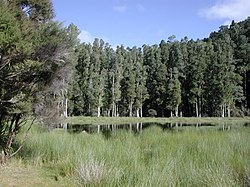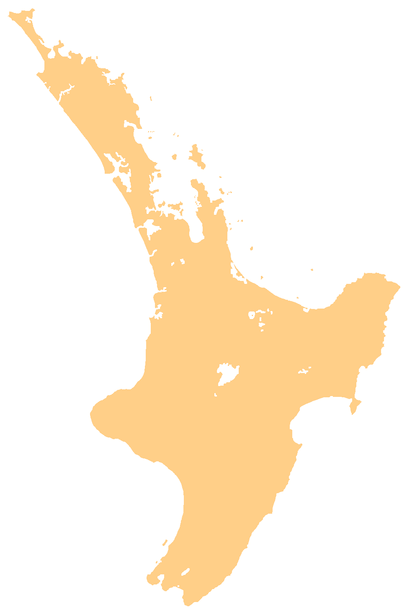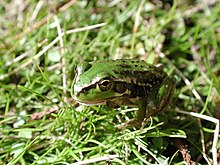Arohaki Lagoon
Arohaki Lagoon (formerly Arahaki Lagoon) is a small ephemeral lagoon located in the Whakatāne District of the North Island, New Zealand. It is within the Whirinaki Te Pua-a-Tāne Conservation Park, south and can be accessed via a 6-kilometre (3.7 mi) walking track.[1]
| Arohaki Lagoon | |
|---|---|
| Arahaki Lagoon | |
 Arohaki Lagoon, with kahikatea trees in the background | |
 Arohaki Lagoon Location of Arohaki Lagoon in the North Island | |
| Location | Whirinaki Te Pua-a-Tāne Conservation Park, North Island, New Zealand |
| Coordinates | 38°40′50″S 176°39′40″E |
| Type | lagoon |
| Native name | Arohaki (Māori) |
Etymology
The Ngāti Whare Claims Settlement Act 2012 changed the name of the lagoon from Arahaki to Arohaki.[2] According to the Ngāti Whare Deed of Settlement, the name is taken from a description of "the taking off of the birds, one by one, circling around".[3]
Significance to Māori
Arohaki Lagoon holds significance for the local iwi, Ngāti Whare. It is seasonally used as a mahinga manu (bird gathering place), and the fish in the lagoon were used as a food source.[3]
Fauna and flora

Arohaki Lagoon contains kōkopu (native galaxiid fish), and serves as a sanctuary and breeding ground for various bird species.[3] Frogs can also be found at the lagoon.[1]
The lagoon contains a large population of water brome (Amphibromus fluitans), a threatened species of native grass.[4][5] Kahikatea trees line the perimeter of Arohaki Lagoon.[1]
References
- "Arohaki Lagoon Track". Department of Conservation. n.d. Retrieved 2020-06-14.
- "Notice of Treaty of Waitangi Settlement Altered Geographic and Crown Protected Area Names for Ngati Whare" (PDF). New Zealand Gazette. No. 52. Wellington, New Zealand: New Zealand Government. 2012-05-10. pp. 1468–1469. Retrieved 2020-06-14.
- Schedule to the Deed of Settlement of the Historical Claims of Ngāti Whare (PDF) (Report). New Zealand Government. 2009. p. 47.
- "Big Population of Water Brome (Amphibromus Fluitans) Discovered At Arohaki Lagoon, Whirinaki" (Press release). New Zealand Plant Conservation Network. 2006-03-20. Retrieved 2020-06-14.
- de Lange, P. J.; Rolfe, J. R.; Barkla, J. W.; Courtney, S. P.; Champion, P. D.; Perrie, L. R.; Beadel, S. M.; Ford, K. A.; Breitwieser, I.; Schönberger, I.; Hindmarsh-Walls, R.; Heenan, P. B.; Ladley, K. (2018). Conservation status of New Zealand indigenous vascular plants, 2017 (PDF) (Report). Department of Conservation. p. 31. ISSN 2324-1713. Retrieved 2020-06-14.